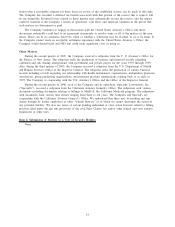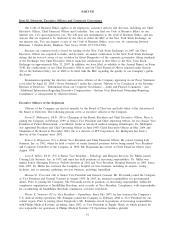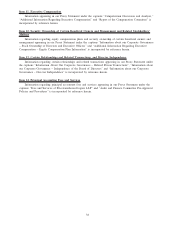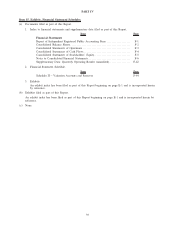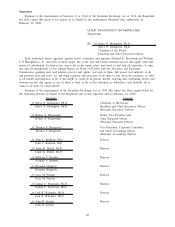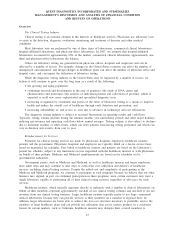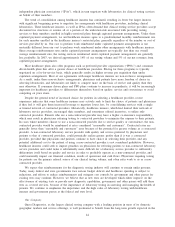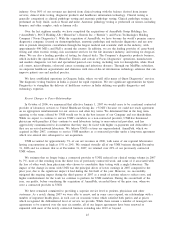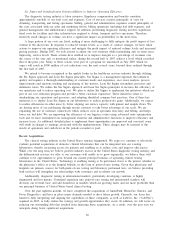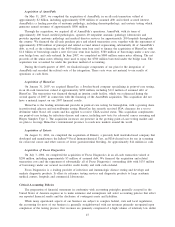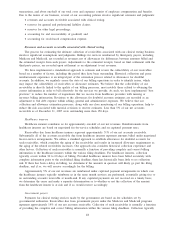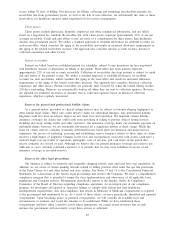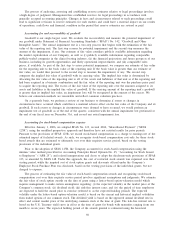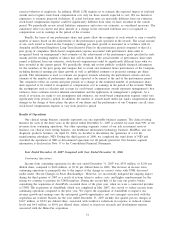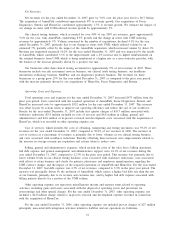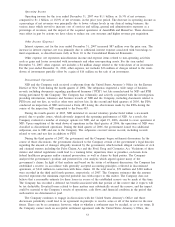Quest Diagnostics 2007 Annual Report Download - page 52
Download and view the complete annual report
Please find page 52 of the 2007 Quest Diagnostics annual report below. You can navigate through the pages in the report by either clicking on the pages listed below, or by using the keyword search tool below to find specific information within the annual report.QUEST DIAGNOSTICS INCORPORATED AND SUBSIDIARIES
MANAGEMENT’S DISCUSSION AND ANALYSIS OF FINANCIAL CONDITION
AND RESULTS OF OPERATIONS
Overview
The Clinical Testing Industry
Clinical testing is an essential element in the delivery of healthcare services. Physicians use laboratory tests
to assist in the detection, diagnosis, evaluation, monitoring and treatment of diseases and other medical
conditions.
Most laboratory tests are performed by one of three types of laboratories: commercial clinical laboratories;
hospital-affiliated laboratories; and physician-office laboratories. In 2007, we estimate that hospital-affiliated
laboratories accounted for approximately 60% of the market, commercial clinical laboratories approximately one-
third and physician-office laboratories the balance.
Orders for laboratory testing are generated from physician offices, hospitals and employers and can be
affected by a number of factors. For example, changes in the United States economy can affect the number of
unemployed and uninsured, and design changes in healthcare plans can affect the number of physician office and
hospital visits, and can impact the utilization of laboratory testing.
While the diagnostic testing industry in the United States may be impacted by a number of factors, we
believe it will continue to grow over the long term as a result of the following:
•the growing and aging population;
•continuing research and development in the area of genomics (the study of DNA, genes and
chromosomes) and proteomics (the analysis of individual proteins and collections of proteins), which is
expected to yield new, more sophisticated and specialized diagnostic tests;
•increasing recognition by consumers and payers of the value of laboratory testing as a means to improve
health and reduce the overall cost of healthcare through early detection and prevention; and
•increasing affordability of, and access to, tests due to advances in technology and cost efficiencies.
The diagnostic testing industry is subject to seasonal fluctuations in operating results and cash flows.
Typically, testing volume declines during the summer months, year-end holiday periods and other major holidays,
reducing net revenues and operating cash flows below annual averages. Testing volume is also subject to declines
due to inclement weather or other events, which can deter patients from having testing performed and which can
vary in duration and severity from year to year.
Reimbursement for Services
Payments for clinical testing services are made by physicians, hospitals, employers, healthcare insurers,
patients and the government. Physicians, hospitals and employers are typically billed on a fee-for-service basis
based on negotiated fee schedules. Fees billed to healthcare insurers and patients are based on the laboratory’s
patient fee schedule, subject to any limitations on fees negotiated with the healthcare insurers or with physicians
on behalf of their patients. Medicare and Medicaid reimbursements are based on fee schedules set by
governmental authorities.
Government payers, such as Medicare and Medicaid, as well as healthcare insurers and larger employers,
have taken steps and may continue to take steps to control the cost, utilization and delivery of healthcare
services, including clinical testing services. Despite the added cost and complexity of participating in the
Medicare and Medicaid programs, we continue to participate in such programs because we believe that our other
business may depend, in part, on continued participation in these programs, since certain customers may want a
single laboratory capable of performing all of their clinical testing services, regardless of who pays for such
services.
Healthcare insurers, which typically negotiate directly or indirectly with a number of clinical laboratories on
behalf of their members, represent approximately one-half of our clinical testing volumes and one-half of our net
revenues from our clinical testing business. Larger healthcare insurers typically prefer to use large commercial
clinical laboratories because they can provide services to their members on a national or regional basis. In
addition, larger laboratories are better able to achieve the low-cost structures necessary to profitably service the
members of large healthcare plans and can provide test utilization data across various products in a consistent
format. In certain markets, such as California, healthcare insurers may delegate their covered members to
43


